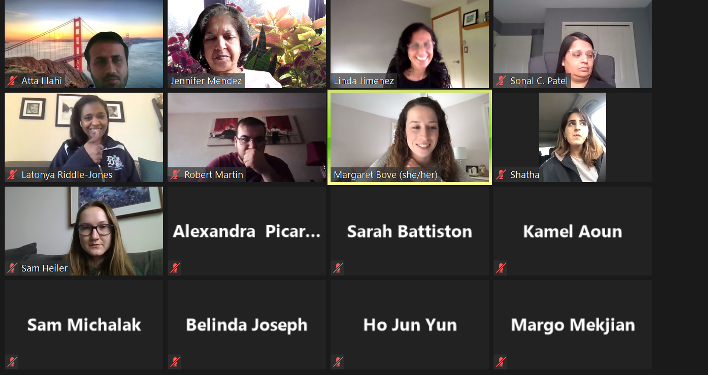Doctors and designers: New collaboration teaches future physicians how to create educational materials for patients
Providing instruction is becoming a skill aspiring health care providers must develop. Physicians, in particular, should be proficient in educating their patients about practices, processes and procedures to help them achieve desired health outcomes. A new collaboration between the learning design and technology program in the College of Education, the School of Medicine, and the Office for Teaching and Learning is helping second-year medical students develop skills in instructional design.
Dr. Jennifer Mendez and Dr. Latonya-Riddle Jones of the Wayne State University School of Medicine co-direct a service-learning course in which medical students create patient education projects focused on chronic illness. The purpose of the course is to foster professional identity formation through community service. One assignment requires students to evaluate the health care needs of a specific patient or population and design an education plan to empower that patient or population to manage their own care between annual check-ups with primary care physicians. Students will use educational materials they develop to inform patients of potential risks and options for healthier lifestyles.
Mendez and Riddle-Jones enlisted assistance from the learning design and technology program and the Office for Teaching and Learning to give students the instructional design skills necessary to create quality educational materials that patients could understand and that physicians could present in a friendlier manner.
“We felt it was important to provide students with the information and support they needed to be successful in designing instruction for their patients,” said Mendez. “We also wanted to raise their awareness of the expertise and resources already available to them on campus. The Office for Teaching and Learning and the learning design and technology program were natural partners.”
Office for Teaching and Learning staff members Ligia Pamfilie, an instructional designer, and Brooke Shafar, an e-learning specialist, provided students with tips on the format for potential projects at the beginning of the course. They developed an eight-minute YouTube video to share ideas and resources such as graphic design tools and document templates with students before they started the assignment.
Tonya Whitehead, associate director of the Office for Teaching and Learning, said the collaboration not only helps students but also benefits the community.
“We were happy to provide Dr. Mendez with information students could use and connect faculty across campus to support student success,” she said. “One of the most interesting aspects of this project is that the materials students produce will be posted in the Digital Commons so that the public can access them. This will create a library of resources that can support public health in the local community and beyond.”
 Linda Jiménez, Ph.D. ’20, coordinator and senior lecturer for the learning design and technology program in the College of Education, hosted a Q&A session to offer students guidance on designing instruction and managing challenges that may arise before they begin using their learning products at student-run and community clinics. She is excited about the opportunity to expose physicians in training to instructional design.
Linda Jiménez, Ph.D. ’20, coordinator and senior lecturer for the learning design and technology program in the College of Education, hosted a Q&A session to offer students guidance on designing instruction and managing challenges that may arise before they begin using their learning products at student-run and community clinics. She is excited about the opportunity to expose physicians in training to instructional design.
“More frequently, physicians and other health care professionals are asked to provide instruction to various audiences, whether it be their patients or other health care providers,” said Jiménez. “Understanding instructional design principles and processes can prove helpful to individuals who want to improve learning and performance in a variety of settings. The learning design and technology program positions and prepares students to identify and address gaps at all levels within organizations, so I am thrilled to share my knowledge with these students as they create learning experiences for their patients.”
Graduates of the program who work in health care agree that studying learning design and technology has enhanced their ability to provide quality instruction and care to patients.
“The learner-centered design focus of the learning design and technology program has helped remind me to bring the clinician — and, therefore, the patient — into the center of every learning experience we design,” said Preston Kelly, M.Ed. ’16, Ph.D. ’20, manager of training and support in health information technology and services for a large academic medical center in Michigan. “This has allowed our learning to be focused on how the clinician can use the information in service to their patients instead of an additional task that pulls them away from delivering world-class health care.”
“Understanding instructional design would benefit healthcare professionals who are educating the public,” said Rose Brewart, M.Ed. ’19, a medical laboratory scientist for a local health care system. “It would provide them with the right tools and resources to design learning materials that most benefit their patients.”
Jiménez hopes the learning design and technology program will have the chance to develop more strategic partnerships across campus to support student success.
“The world’s problems continue to become more complex, and the critical thinking, communication, collaborative and creative skills that students develop in this program can be applied in any organization,” she said. “We welcome opportunities to work with other programs whose students could benefit from learning how to take a design thinking approach to problem-solving or to engage in initiatives that provide opportunities for our students to gain hands-on experience in instructional design.”
To download student projects, visit digitalcommons.wayne.edu/patienteducation.